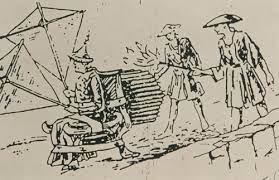YURI GAGARIN, the first man in space, is believed to have said that exploration “is not the work of one man or even a group of men. It is a historical process that humanity carries out in accordance with the natural laws of human development.”
In terms of exploring the heavens, Chinese people might be the most persistent practitioners on the globe, with various stories of people striving to reach the skies over centuries.

On 15 April this year, the Shenzhou 13 Spacecraft (神舟十三號) carried three PLAAC (People’s Liberation Army Astronaut Corps) astronauts back home to China after a successful space voyage. There have already been eight crewed spaceflights in the country.
Such journeys often remind people in China of the legend of Wan Hu—who is said to have tried to make a similar journey centuries ago.
ATTEMPTS TO FLY
But before we get to him, there are earlier stories. Historical records suggest that the rather cruel Emperor Wenxuan of Northern Qi, way back in AD 559, decided to attach prisoners to kites and launch them off the top of a high tower as an experiment. Most died straight away, although one Yuan Huangtou was said to have travelled some distance and landed safely – before being returned to his cell.
A European legend said that an Andulasian man named Abbas ibn Firnas attempted to glide from a tower using artificial wings covered with real bird feathers in the 800s. He was injured but survived. A similar tale is told about Eilmer of Malmesbury, an English monk who lived in the early 11th century.
THE REMARKABLE MR TAO
Then the action returns to China. It was said that at the end of 14th century, during the Ming Dynasty, there lived a young man surnamed Tao (陶), who was what we would today call a “science geek”, spending his time doing experiments. Once, during the process of refining pills with fire, the furnace exploded. The explosion triggered a strong interest in firearms. He successfully upgraded a series of firearms, which were shown to the Emperor and eventually used on the battlefields. To reward the young man, the Emperor elevated him with a new name, Wan Hu (萬戶).
With the support of Emperor, Wan Hu’s experiments were working better, and he decided that he would use the power of gunpowder to rise into the air and see the land from the point of view of a bird.
Wan Hu’s space vehicle was a chair, and its propulsion system was 47 fireworks-style rockets strapped to the back of it.

The story goes that a team of servants with candles stood behind to light all the rockets at the same time. One of the legends even gives the dialogue. “Sir, I’m so scared now,” said one of the servants, his hands trembling.
“What are you scared of?” Wan asked.
“If your attempt to fly fails, you will die,” the man answered.
Wan laughed and answered: “Flying to the sky is the shared dream of our people for thousands of years. I would be willing to die smashed into pieces of the exploration of the skies is successful. Don’t worry about me. Just set fire to the rockets.”
The servants obeyed. Suddenly there was a huge boom and a dazzle of fire.
In some versions of the tale, he succeeds in rising into the air, and uses the kites to bring himself down. In other versions, the experiment fails, and in some Wan Hu disappears entirely, never to be seen again.
SAD ENDING
During an episode of Mythbusters, a TV show, scientists attempted to recreate the experiment using a crash test dummy but didn’t manage to get a positive result.

But the fact that the Wan Hu story has negative endings does imply that the story is at least partly based on truth, and there is even a crater on the moon named “Wan Hoo” to commemorate the Ming Dynasty experiment.
Coming back to modern times, today there have been eight crewed spaceflights from China, and countless flights in aircraft. But somehow it seems likely that the journey of Wan Hu in his rocket-fired chair will be the historical Chinese flight story that no one in the country will forget.
This report includes information from: QQ.

